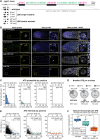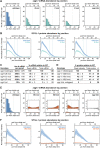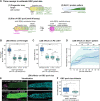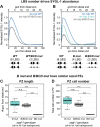Notch-dependent DNA cis-regulatory elements and their dose-dependent control of C. elegans stem cell self-renewal
- PMID: 35394007
- PMCID: PMC9058496
- DOI: 10.1242/dev.200332
Notch-dependent DNA cis-regulatory elements and their dose-dependent control of C. elegans stem cell self-renewal
Abstract
A long-standing biological question is how DNA cis-regulatory elements shape transcriptional patterns during metazoan development. Reporter constructs, cell culture assays and computational modeling have made major contributions to answering this question, but analysis of elements in their natural context is an important complement. Here, we mutate Notch-dependent LAG-1 binding sites (LBSs) in the endogenous Caenorhabditis elegans sygl-1 gene, which encodes a key stem cell regulator, and analyze the consequences on sygl-1 expression (nascent transcripts, mRNA, protein) and stem cell maintenance. Mutation of one LBS in a three-element cluster approximately halved both expression and stem cell pool size, whereas mutation of two LBSs essentially abolished them. Heterozygous LBS mutant clusters provided intermediate values. Our results lead to two major conclusions. First, both LBS number and configuration impact cluster activity: LBSs act additively in trans and synergistically in cis. Second, the SYGL-1 gradient promotes self-renewal above its functional threshold and triggers differentiation below the threshold. Our approach of coupling CRISPR/Cas9 LBS mutations with effects on both molecular and biological readouts establishes a powerful model for in vivo analyses of DNA cis-regulatory elements.
Keywords: sygl-1; Gradient; Homotypic cluster; Spatiotemporal resolution; Transcription factor binding site; smFISH.
© 2022. Published by The Company of Biologists Ltd.
Conflict of interest statement
Competing interests The authors declare no competing or financial interests.
Figures






Similar articles
-
LST-1 is a bifunctional regulator that feeds back on Notch-dependent transcription to regulate C. elegans germline stem cells.Proc Natl Acad Sci U S A. 2023 Sep 26;120(39):e2309964120. doi: 10.1073/pnas.2309964120. Epub 2023 Sep 20. Proc Natl Acad Sci U S A. 2023. PMID: 37729202 Free PMC article.
-
Analysis of the C. elegans Germline Stem Cell Pool.Methods Mol Biol. 2023;2677:1-36. doi: 10.1007/978-1-0716-3259-8_1. Methods Mol Biol. 2023. PMID: 37464233
-
SYGL-1 and LST-1 link niche signaling to PUF RNA repression for stem cell maintenance in Caenorhabditis elegans.PLoS Genet. 2017 Dec 12;13(12):e1007121. doi: 10.1371/journal.pgen.1007121. eCollection 2017 Dec. PLoS Genet. 2017. PMID: 29232700 Free PMC article.
-
GLP-1 Notch-LAG-1 CSL control of the germline stem cell fate is mediated by transcriptional targets lst-1 and sygl-1.PLoS Genet. 2020 Mar 20;16(3):e1008650. doi: 10.1371/journal.pgen.1008650. eCollection 2020 Mar. PLoS Genet. 2020. PMID: 32196486 Free PMC article.
-
The regulatory network controlling the proliferation-meiotic entry decision in the Caenorhabditis elegans germ line.Curr Top Dev Biol. 2006;76:185-215. doi: 10.1016/S0070-2153(06)76006-9. Curr Top Dev Biol. 2006. PMID: 17118267 Review.
Cited by
-
Synthetic guide sequence to generate CRISPR-Cas9 entry strains in C. elegans.bioRxiv [Preprint]. 2025 Jun 16:2025.06.16.659939. doi: 10.1101/2025.06.16.659939. bioRxiv. 2025. Update in: MicroPubl Biol. 2025 Jul 11;2025. doi: 10.17912/micropub.biology.001694. PMID: 40666994 Free PMC article. Updated. Preprint.
-
Aging disrupts spatiotemporal regulation of germline stem cells and niche integrity.Biol Open. 2024 Jan 15;13(1):bio060261. doi: 10.1242/bio.060261. Epub 2024 Jan 15. Biol Open. 2024. PMID: 38156664 Free PMC article.
-
LST-1 is a bifunctional regulator that feeds back on Notch-dependent transcription to regulate C. elegans germline stem cells.Proc Natl Acad Sci U S A. 2023 Sep 26;120(39):e2309964120. doi: 10.1073/pnas.2309964120. Epub 2023 Sep 20. Proc Natl Acad Sci U S A. 2023. PMID: 37729202 Free PMC article.
-
Analysis of the C. elegans Germline Stem Cell Pool.Methods Mol Biol. 2023;2677:1-36. doi: 10.1007/978-1-0716-3259-8_1. Methods Mol Biol. 2023. PMID: 37464233
-
Synthetic guide sequence to generate CRISPR-Cas9 entry strains in C. elegans.MicroPubl Biol. 2025 Jul 11;2025:10.17912/micropub.biology.001694. doi: 10.17912/micropub.biology.001694. eCollection 2025. MicroPubl Biol. 2025. PMID: 40718578 Free PMC article.
References
Publication types
MeSH terms
Substances
Grants and funding
LinkOut - more resources
Full Text Sources
Medical

